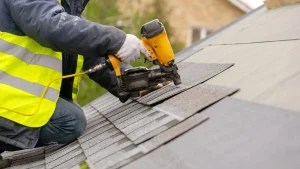Homeowners often face the intimidating task of roof replacement without fully understanding the process involved. A thorough approach begins with evaluating the current roof’s condition. This critical step helps determine whether replacement is necessary. Selecting suitable materials follows, impacting both aesthetics and durability. Understanding the timeline and installation steps is essential. But what happens after the new roof is in place? Exploring post-installation maintenance is equally important to guarantee long-term performance.
Key Takeaways
- Begin by assessing your roof for visible damage, age, and signs of mold or rot before considering replacement.
- Choose the right roofing materials by evaluating options like asphalt shingles, metal, tiles, or wood based on durability and maintenance.
- Understand the typical roof replacement timeline, which usually spans one to two weeks from consultation to installation.
- Follow the proper installation process: inspect the roof, remove old materials, install new underlayment, and lay down the chosen roofing material.
- After installation, maintain your roof with regular inspections, gutter cleaning, and ventilation checks to ensure longevity and performance.
Assessing the Need for Roof Replacement
How can a homeowner determine if roof replacement is necessary? Evaluating the condition of a roof involves several key factors. Homeowners should inspect for visible damage, such as missing shingles, leaks, or sagging areas. Age is another important consideration; roofs typically last 20 to 30 years, depending on materials and maintenance. A thorough examination may also include checking for mold or rot in wooden structures. If repairs are becoming frequent and costly, it may signal the need for replacement. Understanding what is the roof replacement process is vital for making informed decisions. Engaging a professional for a detailed roof inspection can provide clarity and guarantee safety, fostering a sense of community and belonging among homeowners who prioritize their living environment.
Selecting the Right Roofing Materials
When homeowners consider roof replacement, selecting the right roofing materials becomes an essential decision that impacts both aesthetics and functionality. Various options are available, including asphalt shingles, metal, tiles, and wood. Each material offers distinct benefits, such as durability, energy efficiency, and maintenance requirements. Asphalt shingles are popular for their affordability and variety of styles, while metal roofing is known for its longevity and resistance to harsh weather. Tile roofs provide a classic look but may require additional structural support. Homeowners should also consider local climate, architectural style, and budget constraints. Ultimately, choosing the right roofing materials not only enhances the home’s curb appeal but also contributes to its long-term value and performance, making it a critical element of the roof replacement process.
The Roof Replacement Timeline
After selecting the right roofing materials, understanding the timeline for roof replacement is essential for homeowners. Typically, this process takes about one to two weeks, depending on various factors. Initially, homeowners can expect a consultation and assessment phase, which may last a few days. Following this, the actual removal of the old roof usually takes one to three days, depending on the size and complexity. Once the new materials arrive, installation can take an additional three to five days. Weather conditions and unexpected issues may extend the timeline, but clear communication with the roofing contractor can help manage expectations. Ultimately, knowing the roof replacement timeline equips homeowners with the insight needed to navigate this significant undertaking effectively.
The Installation Process Explained
What steps are involved in the installation of a new roof? The process begins with a thorough inspection of the existing roof, identifying any areas that require repair or replacement. Next, the roofing team removes old shingles and underlayment, ensuring a clean surface for the new materials. They then install new underlayment to provide an additional layer of protection against moisture. Following this, the chosen roofing material—be it asphalt shingles, metal, or tiles—is carefully laid down, ensuring proper alignment and secure fastening. Flashing is installed around chimneys and vents to prevent leaks. Finally, the team performs a detailed inspection to confirm everything is secure and functional. Understanding the roof replacement process helps homeowners feel more confident and connected throughout this essential journey.
Post-Installation Considerations and Maintenance
Although the new roof installation may seem complete, several post-installation considerations and maintenance tasks are essential for guaranteeing its longevity and effectiveness. Homeowners should schedule a thorough inspection within the first year to identify any potential issues early. Regularly cleaning gutters and downspouts will prevent water damage and guarantee proper drainage. It is also advisable to check for any signs of wear or damage after severe weather events. Additionally, maintaining proper ventilation in the attic can help prevent moisture buildup, which can weaken roofing materials. Finally, homeowners should keep an eye on the surrounding landscape, trimming overhanging branches to reduce debris accumulation. By prioritizing these post-installation tasks, homeowners can greatly extend the life of their new roof, contributing to their overall peace of mind.
Frequently Asked Questions
How Do I Choose a Reliable Roofing Contractor?
To choose a reliable roofing contractor, one should research credentials, read reviews, request quotes, verify insurance, and seek recommendations. This thorough approach guarantees selecting a trustworthy professional to complete the necessary roof replacement process effectively.
What Permits Are Required for Roof Replacement?
Permits for roof replacement typically include building permits and, in some areas, specific zoning permits. Homeowners should consult local regulations to guarantee compliance and avoid potential fines or complications during the roof replacement process.
Can I Stay in My Home During the Replacement?
Homeowners can often remain in their homes during roof replacement, though noise and disruption may occur. It’s advisable to communicate with the contractor to guarantee safety and comfort during the process, enhancing the overall experience.
What Happens to My Landscaping During the Process?
During the roof replacement process, landscaping may be affected by equipment and debris. Homeowners should take precautions, such as covering plants and moving delicate items, to protect their outdoor spaces from potential damage and disruption.
How Do I File an Insurance Claim for Roof Damage?
To file an insurance claim for roof damage, one should document the damage, contact their insurance provider, and submit the necessary forms and evidence, ensuring to follow their specific guidelines for a smooth claims process.
Conclusion
To summarize, understanding the roof replacement process is crucial for homeowners to navigate their project confidently. From evaluating the need for replacement and choosing suitable materials to grasping the timeline and installation steps, each phase plays an essential role in ensuring a successful outcome. Additionally, post-installation maintenance is key to protecting the investment. By following this guide, homeowners can approach their roof replacement with clarity and assurance, ultimately enhancing the longevity and value of their home.
You May Also Like To Read:







